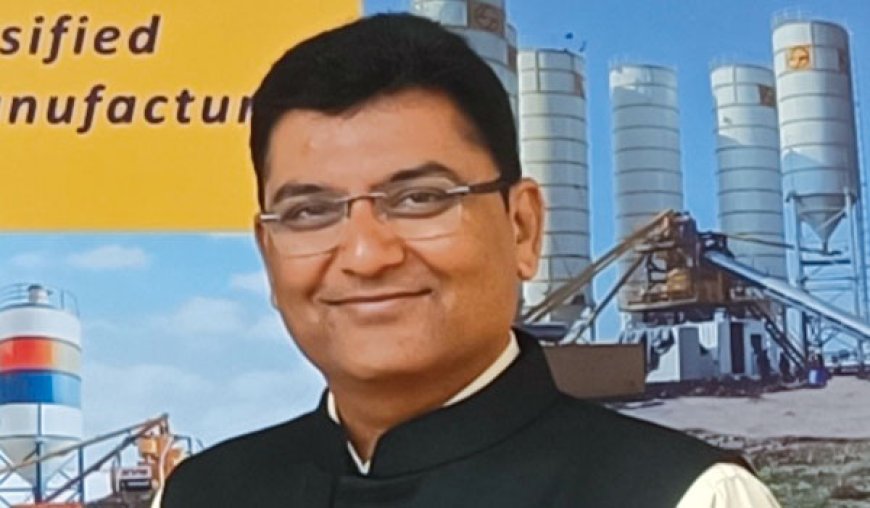Many companies are embracing digitalization and automation to enhance productivity and streamline their operations.
Kalpesh Soni, Vice President – Marketing, KYB Conmat How do you look at the present state of the concrete equipment manufacturing industry in India? How do government policies or regulations impact your manufacturing operations in India? With an emphasis on

How do you look at the present state of the concrete equipment manufacturing industry in India? How do government policies or regulations impact your manufacturing operations in India?
With an emphasis on rebuilding infrastructure, sustainable buildings, and smart cities, construction companies that embrace the industry’s changing landscape will have more opportunities. Investments in infrastructure are the main growth drivers of the construction equipment industry.
Several factors which will have an impact on the CE Industry and will be important for deciding its future direction are:
Economic Conditions and Government Policies: With Government’s impetus on high quality infrastructure and subsequent initiatives like Bharatmala, Sagarmala and focus on developing Physical, Digital and Social Infrastructure, the industry is quite optimistic for the future.
Emission Norms: The implementation of BS V emission norms is expected to affect the construction equipment industry, influencing product costs and market competitiveness and will require the CE industry to invest in cleaner and more environmentally friendly technologies. Companies that are well-prepared to meet these standards will have a competitive advantage.
Technological Advancements: It is necessary to stay informed about technological advancements within the CE industry. Innovations that improve efficiency, sustainability, and digital integration can significantly influence the industry’s prospects.
Global Factors: With the ever-unpredictable global landscape giving rise to many unwanted events, and rising inflation due to this instability, the industry will be under pressure due to rising costs of materials worldwide and will look toward diversifying their supply chain to avoid issues in the long run.
What are the recent standout features or innovations in your concrete equipment that make them unique or more efficient compared to competitors’ products?
We have introduced three new models of self-loading mixers recently. The first, a 2.5 cubic meter capacity mixer is equipped with a 49 HP BS3 Engine, which slashes fuel consumption by an impressive 25 % compared to the competition. The other model CSLM 4.2L, a lighter variant of the 4.3 cubic meter self-loading mixer, operates efficiently with a 74 HP engine, ensuring higher returns for owners, reduced fuel consumption by optimizing performance, and contributing to environmental preservation without requiring AdBlue. Our 4.3 cubic meter mixer features a specialized drum design tailored for low slump concrete and high flow discharge, offering unparalleled versatility for various applications.
How has technology impacted the evolution of concrete equipment manufacturing in your company? Are there specific technological advancements or developments that have significantly enhanced your products in recent years?
Many companies in the construction sector are indeed embracing digitalization and automation to enhance productivity and streamline their operations. Here are some common ways we have integrated smart technologies and automation solutions into our equipment:
Remote Monitoring: Smart sensors and remote monitoring systems allow operators and managers to keep a close eye on equipment performance, fuel consumption, and maintenance needs in real-time, enabling proactive maintenance and reducing downtime.
IoT (Internet of Things): IoT devices and sensors are embedded in equipment to gather data on various parameters like temperature, pressure, and load. This data is analyzed to improve equipment performance and efficiency.
Energy Efficiency: Equipment is being designed to be more energy-efficient, reducing fuel consumption and emissions.
Overall, the integration of smart technologies and automation solutions in our construction equipment’s are aimed at enhancing productivity, reducing operational costs, improving safety, and optimizing resource utilization. These advancements are rapidly transforming the industry and enabling more efficient and sustainable construction practices.
What are the initiatives or features in your products aimed at sustainability or reducing environmental impact?
With heavy focus on R&D backed with strong market research, it enables us to understand the needs of our customers better and serve them with the best products in the market through sustained innovations and improved manufacturing processes. This includes the use of eco-friendly materials and reducing our carbon footprint in the manufacturing process. For example, Our Self-Loading Concrete Mixers machines are IOT enabled, BS-4 and ARAI compliant, offering better fuel efficiency. We make our machines as per latest standards of the emission control and aggressively work towards making our machine more environmentally sustainable in the process.
Hits: 10








